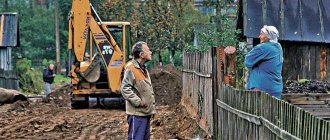Accidents on public life support systems - electric power, sewerage systems, water supply and heating networks are rarely accompanied by loss of life, but they create significant difficulties in life, especially in the cold season.
Accidents on electric power systems can lead to long-term interruptions in power supply to consumers, large areas, disruption of public electric transport schedules, and electric shock to people.
Accidents in sewer systems contribute to the massive release of pollutants and deterioration of the sanitary and epidemiological situation.
Accidents in water supply systems disrupt the supply of water to the population or make water unfit for drinking.
Accidents on heating networks in the winter lead to the impossibility of living in unheated premises and forced evacuation.
Utility systems that provide optimal living conditions for the population include water and gas supply, sewerage, electricity and heat networks. They, just like any technical object, are subject to breakdowns and wear, which leads to accidents. Such emergency situations extremely rarely lead to casualties, but they can significantly complicate the lives of citizens, especially in winter.
Electrical power accidents on public life support systems, the largest example being the breakdown of a reserve unit at the Chagino station in Moscow in 2005, can lead to long interruptions in the supply of electricity, disruption of ground transport schedules, lack of communication, and stoppage of elevators. The consequences can affect fairly large areas, including several thousand people, and the damage usually amounts to millions in losses.
Some of the largest emergency situations at municipal facilities include:
- In 1990, in the Rostov region, there was a breakthrough at the Severnaya-1 sewage pumping station, the consequences of which took 16 years to eliminate. Sewage flowed into the local river, making the situation much worse.
- In Chukotka in 1996, during severe frost, all the boiler houses in the village simultaneously failed due to a pump failure. As a result, about 70 residential buildings were left without heating and electricity for several days. An emergency was declared.
- In the energy sector, the largest accident is considered to be the 2009 incident at the Sayano-Shushenskaya hydroelectric power station. Then, due to dynamic loads, the hydraulic unit cover broke off. The consequences were environmental pollution and the death of more than 50 people. The station itself suffered serious damage, which took several years to repair.
- In 2021, due to an accident at a power plant in St. Petersburg, residents of 3 large areas were left without electricity. For social facilities (hospitals, children's institutions) diesel generator sets were used.
General information about accidents in public utilities
The concept of “accident” implies disruption of the operation of a technical facility, destruction of structures, communications, uncontrolled explosion and (or) release of hazardous substances. Due to various factors, LCS can fail, operate incorrectly, or not operate at full capacity.
Accidents on communal life support systems include breakdown of the sewer system, water supply, and heating networks. If damage is caused to an electrical power facility, this can lead to a prolonged absence of light over a large area, which will affect a number of other areas of life.
The consequence of sewerage accidents is a massive release of pollutants, deterioration of the ecological system, and aggravation of the epidemiological situation.
Disruption of normal water supply systems limits residents' access to clean water. Even if liquid is supplied, it is usually unfit for consumption.
In winter, malfunctions in heating networks pose a particular danger. Since it is impossible to live in unheated premises, the evacuation of residents of entire apartment buildings and even areas is required.
So, accidents in communal life support systems are incidents that disrupt the normal functioning of water, electricity, and gas supply systems.
OFFICIALLY
What are the authorities going to do?
Such proposals for updating the infrastructure were voiced at a meeting with the President on March 31.
— Use infrastructure bonds (their meaning is that they are issued for a specific object that requires large investments, but after some time it is guaranteed to generate, albeit small, income).
-Provide regions with infrastructure budget loans at a rate of up to 3% for a period of up to 15 years or more.
-Expand the Housing and Communal Services Fund program for modernizing municipal infrastructure (several years ago funds were already allocated, in particular, for projects in small towns, but this money has almost run out).
Causes of KSZh accidents
In most cases, communal life support systems fail due to their significant wear and tear, exceeding the warranty period for the use of equipment or communications. ICS work at a high pace, and therefore it is very difficult to adequately restore, repair or update them.
The causes of equipment wear are varied. One of the main factors in the occurrence of emergencies in housing and communal services is disruption of the laying of communications in the ground. LICs work in unfavorable conditions:
- uneven soil pressure;
- deflection from its own weight in subsidence soils;
- water hammer;
- temperature changes;
- external corrosion;
- exposure to an electric field;
- clogging with various deposits.
Units and pumping installations of water distribution networks are subject to wear and corrosion. They are also underground, experiencing the aggressive effects of soil and external phenomena.
The dynamics of corrosion changes depend on the density of the earth. The densest earth rocks almost do not allow oxygen to pass through, which makes the soil aggressive.
Equipment on heating mains and in boiler houses also wears out quickly, which is why emergency situations occur. Most often, problems arise in the autumn-winter period, when the load on the CSF is especially high.
EVERYONE STOP, THIS IS A ROBBERY
In fact, they explained to us from the very first post-Soviet years: housing and communal services need to be transferred to market footing in order to modernize the industry and overcome the old leaking pipes.
In payment systems in the 90s and early 2000s, everyone noticed market rails. For example, in 2005, the increase in tariffs for housing and communal services was more than 30%, in 2006 - almost 25%, in 2009 - about 20%... What about the pipes? I found my old material here from the forum of housing and communal services workers in 2011. There they also talked about the wear and tear of networks on average at 60% (some kind of eternal figure). And also that in 2009-2010, from the Central Federal District alone, 25 billion rubles, which should have been used to improve matters in the public utilities sector, for some reason disappeared to Cyprus and other offshore foreign countries.
By 2014, the authorities admitted that reforms in housing and communal services were still going in a strange direction, which people did not call anything other than “municipal robbery.” It was decided to regulate tariffs by setting maximum indexes for their increase (these are the percentage increases in prices for utilities that we hear about every year on the eve of July 1). Mandatory licensing has been introduced for management companies that service homes. A little later, residents were allowed to switch to direct contracts with water utilities, heating networks and others. This is when payments for utilities are not collected by the management company, but are directly transferred to suppliers of water, heat, etc. (it was assumed that with such a scheme less money would go to Cyprus).
The water utilities and heating networks themselves began to be transferred under concessions. The point here is that the pipes remain state property, but the investor repairs and changes them using his private funds and government subsidies, for which he also takes the income from these pipes.
But happiness in the communal sphere never came...
Emergency situations on heating networks in winter, alas, are not uncommon.
Photo: Alexander CHERNYKH
Classification and consequences of accidents
The following types of accidents at KSZh can be distinguished:
- In drinking water supply systems.
- On public gas pipelines.
- In the field of power supply to the population.
- On heating networks in the cold season.
- In sewer systems.
- On municipal systems with massive emissions of polluting components.
The consequences of major utility accidents affect a wide range of sectors of life, causing a number of problems:
- transport collapse;
- breakdown of communication networks;
- flooding of structures;
- interruption of electricity supply;
- violation of the ground transport schedule;
- loss of connection;
- stopping elevators and so on.
Accidents on sewer network collectors are caused by dilapidated and clogged pipes. This leads to contamination of tap water. The penetration of wastewater into a water intake causes an outbreak of infectious and other diseases. If liquid leaks out, soil contamination may occur.
What causes water supply systems to fail?
Emergencies usually occur at water towers, distribution networks and pumping plants. Less often, repair crews have to deal with damage to water treatment facilities.
Stopping the water supply may occur due to emergency situations at power plants.
To ensure an effective and uninterrupted supply of water to the population, reserve wells are created separately and emergency reserves are formed.
Problems in public gas pipelines
Damage to the gas pipeline is accompanied by destruction or rupture of systems that are located both in the building itself and on distribution networks related to residential buildings or enterprises. Problems less commonly occur at compressors or distribution stations.
The main danger of accidents on public gas pipelines is gas leakage, which can lead to a full-scale explosion and serious damage.
Causes of power outages
Damage to power lines, distribution stations or transformers interrupts the supply of electricity to premises.
To prevent such situations, lines are laid underground. In addition, experts recommend using at least 2 independent power sources and creating backup transformers.
Accidents on heating networks in cold weather
Severe frosts and sudden temperature changes cause ruptures of heating network pipes, which is why boiler rooms stop working.
Since most modern boiler rooms operate on natural gas, accidents on gas pipelines lead to disruptions in the heat supply.
Problems with the sewer system
The cause of accidents in the sewerage system is the failure of sewerage equipment and treatment facilities. This happens because special services clean them untimely or poorly. As a result, blockages occur in communications.
Such accidents are accompanied by the release of pollutants into water bodies or water supply systems. Eliminating environmental disasters takes a long time.
If an accident occurs at a pumping station, the container with fecal waste overflows, so it is released into the environment. To avoid this, you should use a backup electrical generator.
Explosion in Siberia
In the summer of 1982, the largest gas explosion occurred on the Urengoy-Surgut-Chelyabinsk gas pipeline section, the power of which was equal to the explosion of a small nuclear warhead . According to American experts, the flames were clearly visible from space, and it took Soviet firefighters at least 2 months to put out the fire.
This man-made disaster is shrouded in darkness, since at that time in the Soviet Union such incidents were hushed up, so the authorities did not recognize the fact of the accident. It took place in a sparsely populated area, far from large cities, which made it possible to hide all the evidence. Only during perestroika were archives opened, thanks to which the scale of the tragedy became clear.
The causes of the man-made disaster were human negligence and negligence when connecting gas pipeline branches.
How to prepare for possible accidents
To reduce the scale of the consequences of utility incidents, a special set of measures is being developed that should be taken as quickly as possible. Although emergency response services work seven days a week and on holidays, cutting off the supply of water, electricity or gas, even for a short period of time, still causes inconvenience.
Since it is impossible to eliminate the possibility of ICS accidents, it is worth preparing for emergency situations in advance:
- Make sure there are always matches and candles at home.
- Buy flashlights, spare batteries, and a wireless radio.
- Stock up on water and a set of products with a long shelf life.
- Keep a list of emergency services with telephone numbers in a visible place so that all family members can use them.
Effective interaction between residents and specialists makes it possible to eliminate the consequences of an accident within a few hours.
Risk minimization
To prevent an accident from taking you by surprise, you need to make preparations. The deplorable state of certain sections of utility networks when they are loaded indicates that the likelihood of an emergency situation is high. The following set will make you ready for an emergency situation:
- candles, matches, dry alcohol;
- flashlight and battery-powered radio;
- a supply of clean water and products that retain their properties for weeks;
- list of contacts for emergency services.
It is impossible to prevent danger 100%, but it is possible to remain calm and an acceptable level of comfort even in unpleasant situations. Energy suppliers, housing and communal services and service companies are working to ensure that loads are less likely to lead to breakdowns, but it is not yet possible to say with certainty that there is no danger. But there are positive dynamics; during periods of peak load on the power grid, there are no shutdowns, everything continues to operate as normal.
Action plan in case of emergency on utility systems
If an emergency occurs, you should immediately notify the management company or resource supplier. Some organizations operate 24-hour telephone lines for such calls.
If the situation is urgent, you should contact emergency services directly.
When electrical power systems are damaged, voltage surges are possible, which often leads to fires and equipment breakdowns. In this case, you should unplug all the plugs of the devices connected to the network and turn off the power to the room by moving the levers on the panel to the “Off” position.
If the power is out, you should have gas or gasoline burners on hand to cook or reheat food. Candles are used as a light source if there are no drafts in the apartment. Candles are placed away from curtains, wallpaper, and so on.
If damaged electrical wires are found on the street, the police should be notified. Under no circumstances should you approach a broken wire closer than 5-8 m. If it unexpectedly falls nearby, you need to jump out of the danger zone.
Problems in water supply systems are often indicated by humming or noise in the pipes. In the event of an emergency, turn off the water taps. During this period, it is better to buy water for drinking or cooking in stores. For other needs in the warm season, you can take water from reservoirs. To clean it from harmful impurities, the following is used:
- boiling;
- standing for several days in an open container;
- special chemical cleaners;
- silver items.
If an incident requires lengthy repair work, clean drinking water is supplied to residential buildings.
In the absence of heating, heaters are used, and not homemade ones. It is prohibited to heat the apartment, including gas burners or electric kitchen panels - this often leads to fires and poisoning.
To keep warm, you can hang a blanket or blanket on windows, balconies, and entrance doors. Family members can sit in a small room and close the doors tightly to prevent cold air from entering from other rooms. Warm clothing, hot drinks and exercise will help you stay warm.
Find out in detail what functions the emergency housing and communal services service performs.
HOW MANY EMERGENCY NETWORKS ARE IN RUSSIA
According to Deputy Prime Minister Marat Khusnullin, the wear and tear of utility networks in some regions reaches 60-70%. Executive Director of Housing and Communal Services Control Svetlana Razvorotneva calls an even more catastrophic figure - up to 80%, especially in small settlements.
“In many regions we continue to use the Soviet legacy,” she told KP. — In addition to the high degree of wear and tear, this entails another problem. The infrastructure of those times was created without taking into account energy efficiency and resource savings. Unfortunately, we have kilometers of pipes that are simply poorly insulated.
Yes, where the pipe that supplies heat to our nine-story building runs through the yard was especially clearly visible at the end of March. This is a strip where the grass has already begun to turn green, and in a week the coltsfoot will probably turn yellow - although the snow on both sides has not yet melted. And this is the case when early greenery is not encouraging. Because we pay for the greenhouse on the street from year to year through rising heating tariffs. And something else periodically leaks in the basement, which is why we have a swarm of mosquitoes in our apartment until the snow begins. And that, I suspect, is also included in the fee due to some inflated standards.
“Without replacing this pipe from which everything flows, we will not be able to bring housing and communal services to normal costs,” Marat Khusnullin recently said in the “Posner” program on Channel One.
It's hard to argue. There's just a feeling of déjà vu. After all, how many years have they been telling the same thing...
Water utilities and heating networks in Russian cities began to be transferred under concessions.
Photo: Oleg UKLADOV
Major KSZh accidents
Unfortunately, history remembers many emergency incidents related to ICS. Here are just some examples of accidents on public life support systems:
- Breakdown of the reserve unit at the Chagino station, Moscow, 2005. As a result, tens of thousands of people were blocked in railway transport, subways, and elevators. Many commercial and government enterprises could not function normally.
- Breakthrough of the Severnaya-1 sewage pumping station, Rostov region, 1990. The consequences took 16 years to resolve, as wastewater entered the river, which aggravated the situation.
- In extreme cold, all boiler houses in the village of Chukotka stopped working due to a pump breakdown (1996). 70 residential buildings were left without heat for several days.
- The cover of a hydraulic unit breaks off at the Sayano-Shushenskaya HPP, 2009. The accident caused the death of more than 50 people and dealt a serious blow to the environment.
MUNICIPAL TRISHKIN KAFTAN
According to the Ministry of Construction, about 2% of pipes in water supply and heat supply systems with a high degree of wear are replaced annually throughout the country. But you need at least 5%. This was the case in recent years before the pandemic. The situation with it has worsened further, since the collection of payments has fallen (not so much due to citizens who have neglected them, but because of the financial difficulties of organizations - they also receive money for housing and communal services).
“The utility sector is attractive to investors in large cities where there are a large number of consumers,” explains Svetlana Razvorotneva. — A particular headache is the water supply sector, where tariffs are low and wear and tear is high. The Vodokanal Association once calculated that in order to recoup investments in the water utility in the city of Shchekino, Tula Region, it would take 150 years. And how many such small cities and towns do we have...
-The housing and communal services infrastructure is in a deteriorating state; its modernization requires large investments in a short time. Therefore, the choice is often made in favor of spot repairs rather than full reconstruction. But this only delays the moment when the pipes become completely unusable,” Elvira Kunakova , a lawyer at P&P Unity, which provides support for public-private partnership projects (the same concessions), tells us what the situation looks like on the other side of the barrier. — There are also very specific difficulties. Many communal facilities are not registered in the cadastral register. For investors, this means additional difficulties and expenses.
In other words, the same problem as with housing construction. Everyone wants to invest in Moscow and several other megacities. And in the rest of the country... there is no one to even register water supply systems in accordance with current legislation.
Around the country, about 2% of pipes in water supply and heat supply systems with a high degree of wear are replaced annually. But you need at least 5%.
Photo: Evgenia GUSEVA







